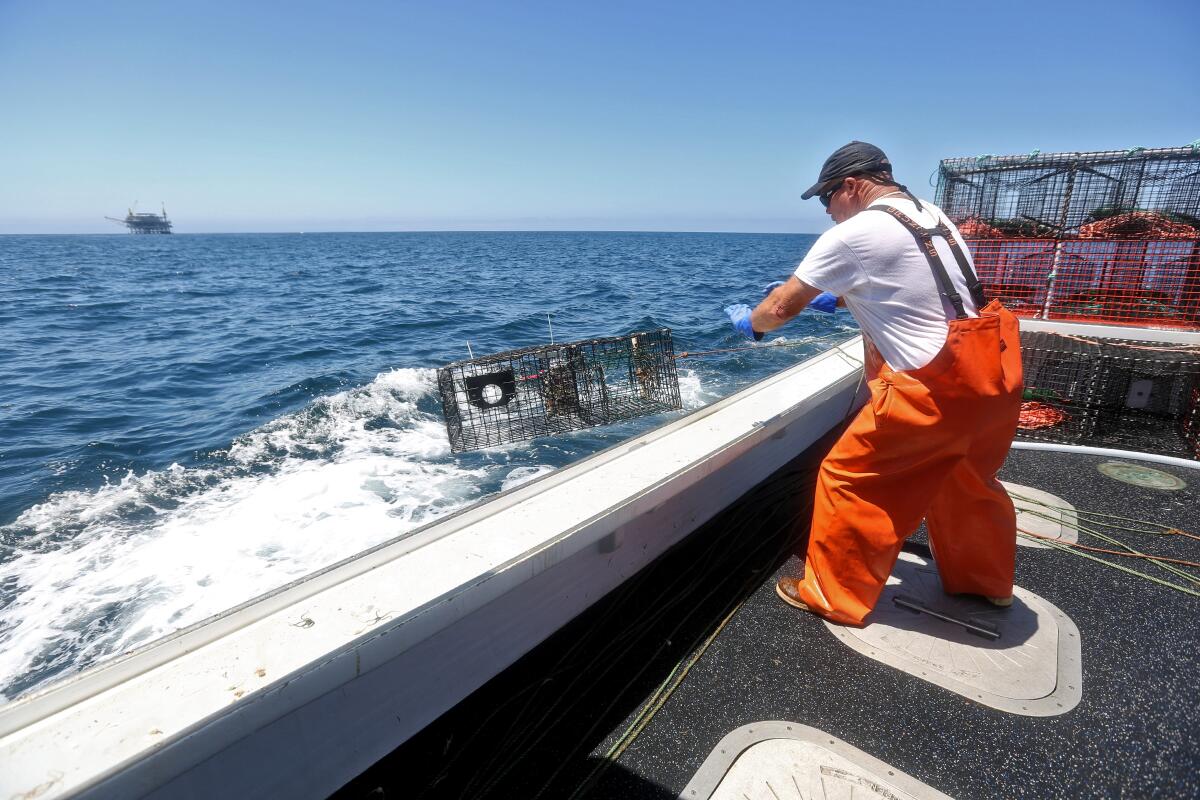West Coast fisheries took steps to protect whales, turtles in 2019

- Share via
West Coast fisheries cleaned up their act in 2019, with new rules to promote sustainable fishing practices and new alliances to protect ecological and economic interests.
The changes include approval of new gear that reduces unwanted catch, safeguards for delicate bottom habitat, and guidelines for managing whole ocean ecosystems, instead of handling species separately.
Those regulations reflect input from regulators, conservationists and fishermen and represent unprecedented compromises among groups that often have been at odds.
In September, the Pacific Fisheries Management Council approved new “deep set buoy” gear for swordfish, to avoid snaring turtles, marine mammals and other unintended catch. Swordfish have typically been caught using vast drift gillnets set overnight, which often ensnare other fish species, sharks, and marine mammals. The new method allows fishermen to drop hooks into deeper waters where swordfish forage during the day, catching the prized fish without ensnaring other animals.
Then, in November, the body voted to uphold an existing ban on longline fisheries on the open ocean off the West Coast. That fishery had been closed to West Coast fishermen since 1989 because of the high numbers of non-target fish and other animals that were caught.
“Those are the two shining examples of where federal fisheries managers are trying to reduce or prevent the expansion of bycatch in the swordfish fishery,” said Gilly Lyons, a policy analyst with the Pew Charitable Trusts, who works on Pacific marine issues.
In November, the National Oceanic and Atmospheric Administration’s Fisheries Service finalized regulations to safeguard more than 140,000 square miles of ocean off the U.S. West Coast. The new rules prohibit bottom trawls — large, weighted fishing nets dragged along the seafloor — off 90 percent of U.S. waters off the West Coast. The measure aims to protect fragile deep-sea coral gardens and sponge beds, which provide shelter and serve as fish nurseries to important species including rockfish, ling cod, sharks, and others.
At the same time, the agency reopened other, less sensitive areas to bottom trawling to accommodate fishing fleets that sought to use those areas. That concession helped secure the support of fishermen for the widespread closures of other deep-sea habitat.
Geoff Shester, California campaign director for the marine environmental group Oceana, said that comprehensive protection represents a rare compromise in this divisive political era. Oceana had previously documented colorful, deepwater corals, capturing video of the fragile seascape using remote rovers on a 2017 expedition.
“For that kind of thing to happen in the current political climate demonstrates many years of hard work and collaboration across (groups that) in the past might have been enemies, but now work together,” Shester said. “It was a collaboration of scientists, the fishermen themselves, and conservation groups that helped bring this together.”
Earlier in the year, NOAA’s Fisheries Service set guidelines for managing whole ocean ecosystems. The plan, approved in May, lays out steps that West Coast fishermen can take to make sustainable business and conservation decisions, continuing to harvest fish while protecting the ecosystems they depend on. While marine regulators have traditionally considered individual species, the plan examines their combined roles in the California Current, to keep West Coast waters healthy and productive.
Next year, marine advocates expect regulators to consider other steps toward sustainable fishing, including new rules for near-shore fisheries, and better management of kelp forests.
“One of the big things that’s coming up is the question of whale entanglements in California fisheries,” Shester said. “Humpback whales, blue whales and leatherback sea turtles are getting caught in fishing gear. The Dungeness crab fishery in Northern California is taking steps now to create a whale-safe and turtle-safe fishery.”
Shester said fishermen and scientists are working to develop ropeless crab traps, which would eliminate the long fishing lines that entangle marine animals and replace them with mechanisms to enable the traps to pop up on demand when fishermen retrieve them.
In addition, California regulators are set to consider new rules for fishing in state waters, from the shoreline to 3 miles out at sea, including updated regulations for California halibut, Lyons said.
“So 2020 will be an important year for how the state manages commercial and recreational fisheries in their own waters, in terms of reducing bycatch, protecting seafloor habitat, and addressing the health of the fisheries themselves,” she said.
Paul Shively, a project director for the Pew Charitable Trusts, said California regulators may also address the health of kelp forests. The vast underwater groves have experienced mass die-offs in Northern California and remain vulnerable to climate change and ocean warming in Southern California.
“California has made a very strong commitment to work on their kelp harvest regulations next year,” he said. “This is a big deal, in that so many young fish rely on that forest as their rearing grounds.”
Brennan writes for the San Diego Union-Tribune.
More to Read
Sign up for Essential California
The most important California stories and recommendations in your inbox every morning.
You may occasionally receive promotional content from the Los Angeles Times.











